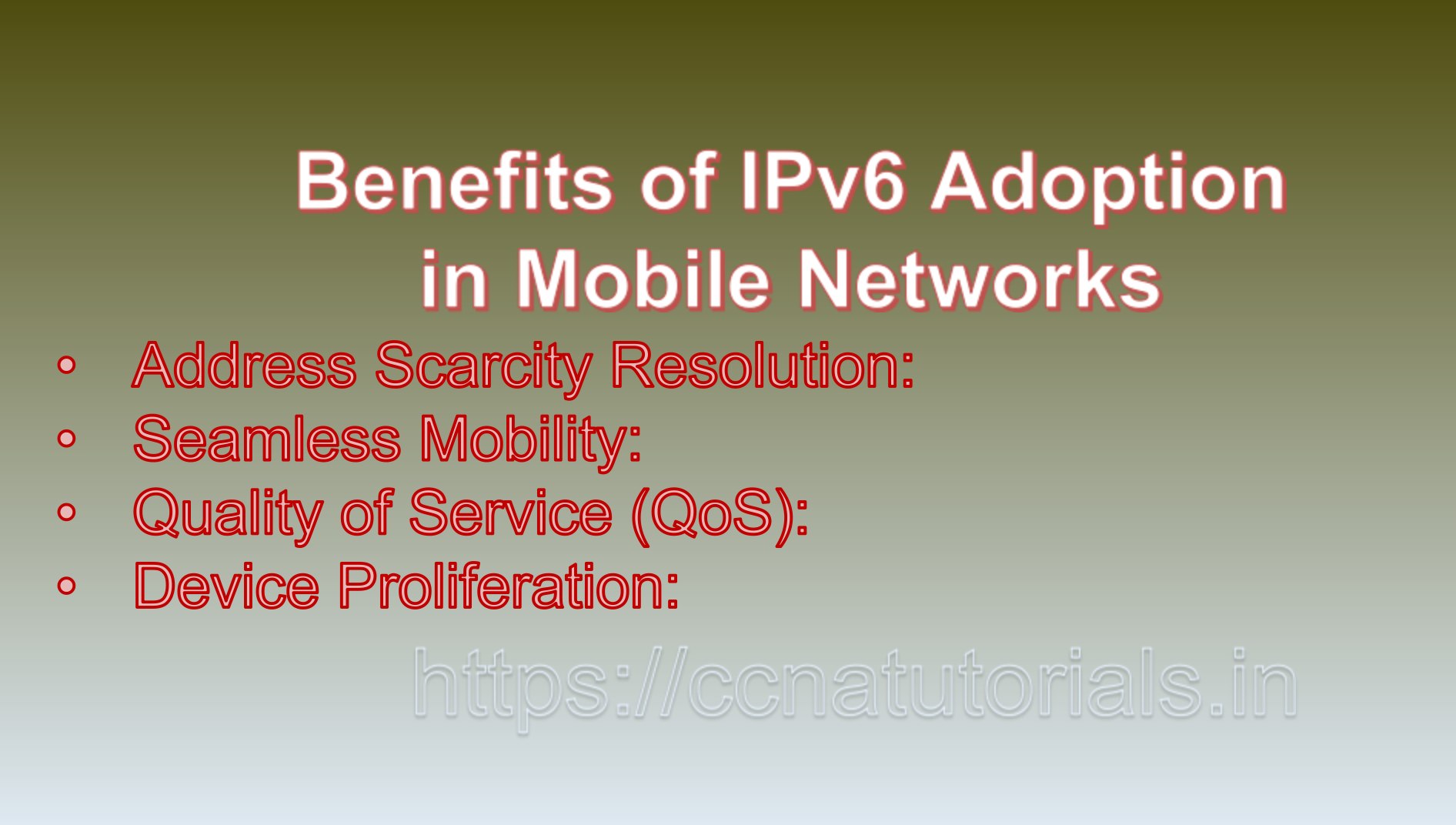Contents of this article
In this article, I describe IPv6 in Mobile Networks: Enabling Seamless Mobility and Connectivity The proliferation of mobile devices and the increasing demand for high-speed data services have transformed the landscape of mobile networks. However, the limited addressing capacity of Internet Protocol version 4 (IPv4) has posed challenges for accommodating the growing number of devices. Internet Protocol version 6 (IPv6) presents a solution by offering an extensive address space and features tailored to the requirements of mobile network. This article explores the integration of IPv6 in mobile network, emphasizing its benefits, implementation strategies, and implications for the future of mobile communication.
1. IPv6’s Role in Mobile Networks:
– Address Space Abundance:
IPv6’s vast address space is critical for supporting the ever-expanding pool of mobile devices, ensuring that each device has a unique and globally routable IP address.
– Efficient Mobility Handling:
IPv6’s simplified header structure and built-in mobility support facilitate the seamless movement of devices across different networks, ensuring continuous connectivity.
– Security Enhancements:
IPv6 incorporates security features such as Internet Protocol Security (IPsec), enhancing data privacy and security for mobile users.
2. Benefits of IPv6 Adoption in Mobile Networks:
– Address Scarcity Resolution:
IPv6 addresses the limitations of IPv4, enabling mobile network to accommodate a virtually unlimited number of connected devices, including smartphones, tablets, wearables, and IoT devices.
– Seamless Mobility:
IPv6’s mobility support allows mobile devices to maintain connections while transitioning between different network types, such as Wi-Fi and cellular, without interrupting services.
– Quality of Service (QoS):
IPv6’s header structure is optimized for efficient routing, enabling better QoS management and improved user experience for data-intensive applications.
3. IPv6 Implementation Strategies in Mobile Networks:
– Dual-Stack Deployment:
– Solution: Mobile operators can deploy dual-stack network that support both IPv4 and IPv6 simultaneously.
– Outcome: This approach ensures backward compatibility with IPv4 devices while paving the way for IPv6 adoption. Devices can communicate using either protocol.
– IPv6-Only Deployment:
– Solution: In greenfield deployments or areas with limited IPv4 resources, mobile operators can opt for IPv6-only network.
– Outcome: IPv6-only networks simplify network management and offer a future-proof foundation for expanding services and accommodating new devices.
4. IPv6 Adoption Challenges and Considerations in Mobile Networks:
– Device Compatibility:
Ensuring that user devices are IPv6-compatible is crucial for a seamless transition. Mobile operators need to ensure that the devices they support are capable of utilizing IPv6 addresses.
– Roaming and Interoperability:
IPv6 adoption requires coordination between mobile operators to ensure that roaming devices can maintain connectivity across different network.
– Legacy Services and Infrastructure:
Mobile networks often rely on legacy systems and services that may not fully support IPv6, requiring careful planning and migration strategies.
5. IPv6 Implementation in Mobile Networks: Examples in Practice:
– Mobile Operator Upgrade:
– Scenario: A mobile operator recognizes the limitations of its existing IPv4 infrastructure and the increasing demand for high-speed data services.
– Solution: The operator deploys dual-stack networks, enabling IPv4 and IPv6 coexistence to ensure backward compatibility while enabling IPv6 adoption.
Outcome:
– Subscribers’ devices can connect seamlessly using either IPv4 or IPv6 addresses.
– The operator prepares for the future by gradually transitioning to IPv6 while maintaining a quality user experience.
– New Market Entry:
– Scenario: A mobile operator expands into a region with limited IPv4 resources but high demand for mobile services.
– Solution: The operator deploys IPv6-only networks that cater to the region’s connectivity needs while future-proofing the network.
Outcome:
– The operator provides robust and efficient connectivity to subscribers in the new region using IPv6-only networks.
– As devices and services evolve, the operator can easily scale its network to accommodate future demands.

In short IPv6 in Mobile Networks Embracing IPv6 for Mobile Networks’ Evolution:
IPv6 integration in mobile networks is essential for meeting the demands of the rapidly evolving mobile landscape. With the proliferation of mobile devices and the advent of 5G technology, IPv6 ensures that mobile operators can provide seamless connectivity and accommodate the growing number of devices. By implementing IPv6 through strategies like dual-stack or IPv6-only deployments, mobile operators can position themselves at the forefront of mobile communication, offering a future-proof foundation for the next generation of connected devices and services. As mobile networks continue to evolve, embracing IPv6 empowers operators to provide users with the best possible experience while adapting to the demands of the digital age.
IPv6 in Mobile Networks: Enabling Seamless Connectivity in a Mobile-First World
In today’s digital landscape, mobile devices have become integral to our daily lives, transforming the way we communicate, work, and access information. As the number of mobile devices continues to grow, the limitations of the current addressing scheme, Internet Protocol version 4 (IPv4), have become evident. Internet Protocol version 6 (IPv6) offers a solution to address this challenge, providing a vast address space and advanced features that are crucial for the efficient functioning of mobile networks. This article explores the integration of IPv6 within mobile networks, highlighting its significance, benefits, and implementation considerations.
1. IPv6’s Role in Mobile Networks:
– Address Space Expansion:
IPv6’s significantly larger address space is essential for accommodating the multitude of mobile devices, IoT devices, and services that rely on mobile networks.
– Simplified Network Management:
IPv6’s autoconfiguration capabilities streamline the management of mobile networks by reducing the need for manual IP address assignment and configuration.
– Efficient Routing:
IPv6’s streamlined header structure improves routing efficiency, resulting in reduced latency and enhanced performance for data-intensive applications.
2. Benefits of IPv6 Adoption in Mobile Networks:
– Device Proliferation:
IPv6’s extensive address space is essential for supporting the growing number of devices connected to mobile networks, including smartphones, tablets, wearables, and IoT devices.
– Seamless Roaming:
IPv6’s autoconfiguration and addressing features ensure that devices can seamlessly roam between different networks without disruptions.
– Quality of Service (QoS):
IPv6’s efficient header structure enables the implementation of QoS mechanisms that prioritize specific types of mobile traffic, ensuring a better user experience.
3. IPv6 Implementation in Mobile Networks:
– Dual-Stack Deployment:
– Solution: Mobile network operators can implement dual-stack networks that support both IPv4 and IPv6 simultaneously.
– Outcome: This approach enables a gradual transition, allowing devices to communicate using either protocol while ensuring connectivity with both IPv4 and IPv6-enabled devices.
– IPv6-Only Deployment:
– Solution: Mobile networks can choose to implement IPv6-only networks, especially for new infrastructure or greenfield deployments.
– Outcome: An IPv6-only deployment simplifies network management and reduces the complexities associated with maintaining dual-stack configurations.
4. IPv6 Deployment Strategies in Mobile Networks:
– Seamless Roaming and IPv6:
– Scenario: A global traveler switches between cellular networks while moving across different countries. Seamless connectivity is crucial for a smooth experience.
– Solution: Mobile network operators implement IPv6 to facilitate seamless roaming. Devices autoconfigure with IPv6 addresses upon joining a new network, ensuring uninterrupted connectivity.
Outcome:
– Travelers experience uninterrupted mobile services, including voice calls, messaging, and data access, regardless of the network they connect to.
– IPv6’s addressing and autoconfiguration mechanisms simplify the roaming process, enhancing the user experience.
– IoT Integration:
– Scenario: An IoT deployment involves thousands of devices transmitting data over a mobile network. Scalability and efficient routing are critical to ensure seamless data transmission.
– Solution: The mobile network operator deploys IPv6 to accommodate the large number of IoT devices. IPv6’s extensive address space ensures each device has a unique address, enabling efficient data exchange.
Outcome:
– IoT devices seamlessly communicate with each other and backend systems using IPv6 addresses.
– The network can accommodate the influx of new IoT devices without facing address exhaustion, ensuring scalability for future IoT deployments.
5. IPv6 Challenges and Considerations in Mobile Networks:
– Device Compatibility:
Ensuring that mobile devices, including older models, are IPv6-compatible is essential for maintaining a seamless user experience.
– Transition Mechanisms:
Implementing transition mechanisms, such as 464XLAT, to facilitate communication between IPv6-only mobile devices and IPv4 services is crucial during the transition phase.
– Network Planning:
Effective network planning and testing are necessary to ensure a smooth transition, as any disruption can impact the user experience and lead to customer dissatisfaction.
6. IPv6 Success Stories in Mobile Networks:
– Global Mobile Operator:
– Scenario: A global mobile operator embraces IPv6 to future-proof its network infrastructure and ensure seamless services for its subscribers.
Outcome:
– The operator implements dual-stack deployment, allowing subscribers’ devices to use either IPv4 or IPv6 addresses based on compatibility.
– Subscribers experience uninterrupted connectivity, even as they move across networks and geographical locations.
– IoT Connectivity:
– Scenario: An IoT service provider launches a nationwide deployment of smart meters using mobile networks to transmit data.
Outcome:
– The provider leverages IPv6’s scalability to accommodate a large number of smart meters, each with its unique address.
– Data transmission from smart meters to backend systems occurs efficiently using IPv6, ensuring reliable and timely data collection.
Conclusion for IPv6 in Mobile Networks: Transforming Mobile Networks with IPv6 for a Connected Future:
The integration of IPv6 within mobile networks is pivotal for ensuring seamless connectivity, accommodating the growing number of mobile and IoT devices, and providing a better user experience. By implementing IPv6 through strategies like dual-stack or IPv6-only deployments, mobile network operators can overcome the limitations of IPv4, positioning their networks for future growth and technological advancements. IPv6 empowers mobile networks to thrive in a mobile-first world, catering to the evolving needs of users and the ever-expanding landscape of connected devices.






